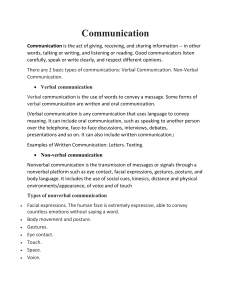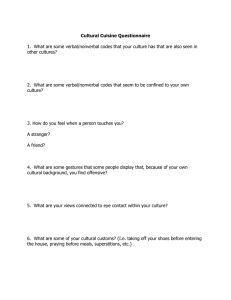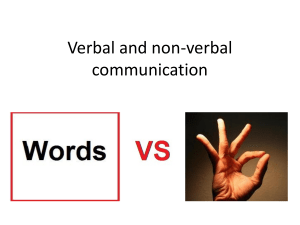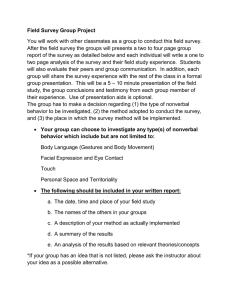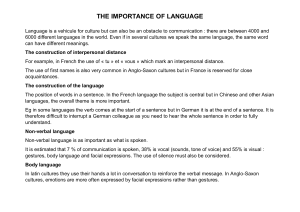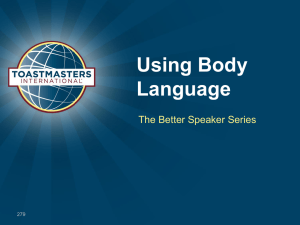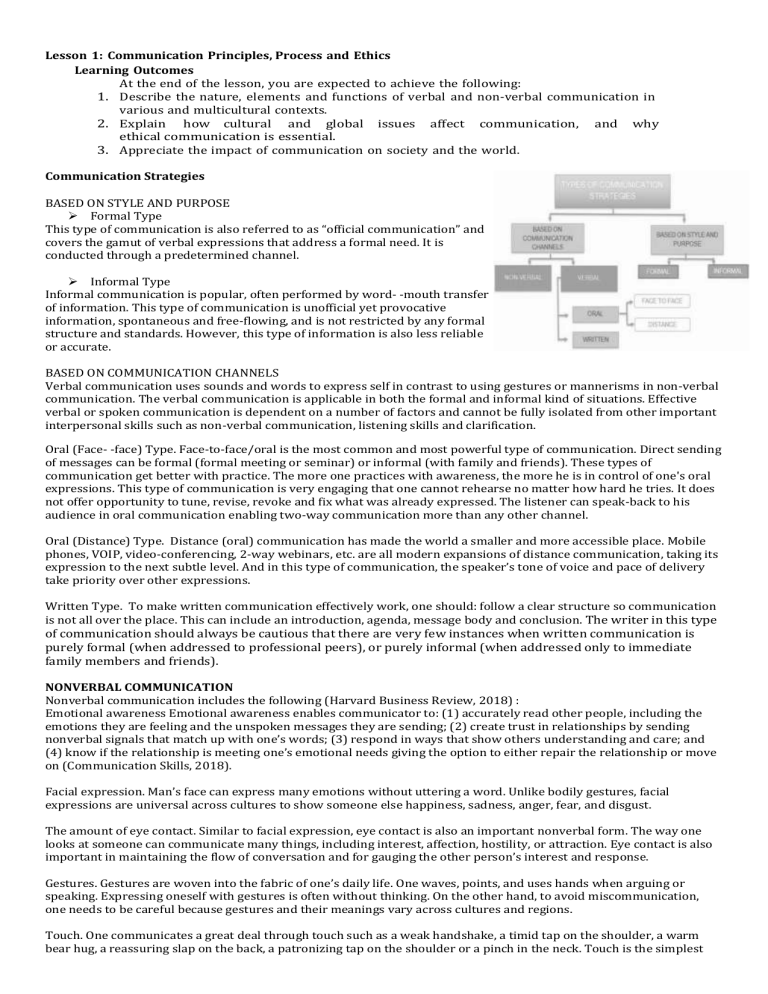
Lesson 1: Communication Principles, Process and Ethics Learning Outcomes At the end of the lesson, you are expected to achieve the following: 1. Describe the nature, elements and functions of verbal and non-verbal communication in various and multicultural contexts. 2. Explain how cultural and global issues affect communication, and why ethical communication is essential. 3. Appreciate the impact of communication on society and the world. Communication Strategies BASED ON STYLE AND PURPOSE Formal Type This type of communication is also referred to as “official communication” and covers the gamut of verbal expressions that address a formal need. It is conducted through a predetermined channel. Informal Type Informal communication is popular, often performed by word- -mouth transfer of information. This type of communication is unofficial yet provocative information, spontaneous and free-flowing, and is not restricted by any formal structure and standards. However, this type of information is also less reliable or accurate. BASED ON COMMUNICATION CHANNELS Verbal communication uses sounds and words to express self in contrast to using gestures or mannerisms in non-verbal communication. The verbal communication is applicable in both the formal and informal kind of situations. Effective verbal or spoken communication is dependent on a number of factors and cannot be fully isolated from other important interpersonal skills such as non-verbal communication, listening skills and clarification. Oral (Face- -face) Type. Face-to-face/oral is the most common and most powerful type of communication. Direct sending of messages can be formal (formal meeting or seminar) or informal (with family and friends). These types of communication get better with practice. The more one practices with awareness, the more he is in control of one's oral expressions. This type of communication is very engaging that one cannot rehearse no matter how hard he tries. It does not offer opportunity to tune, revise, revoke and fix what was already expressed. The listener can speak-back to his audience in oral communication enabling two-way communication more than any other channel. Oral (Distance) Type. Distance (oral) communication has made the world a smaller and more accessible place. Mobile phones, VOIP, video-conferencing, 2-way webinars, etc. are all modern expansions of distance communication, taking its expression to the next subtle level. And in this type of communication, the speaker’s tone of voice and pace of delivery take priority over other expressions. Written Type. To make written communication effectively work, one should: follow a clear structure so communication is not all over the place. This can include an introduction, agenda, message body and conclusion. The writer in this type of communication should always be cautious that there are very few instances when written communication is purely formal (when addressed to professional peers), or purely informal (when addressed only to immediate family members and friends). NONVERBAL COMMUNICATION Nonverbal communication includes the following (Harvard Business Review, 2018) : Emotional awareness Emotional awareness enables communicator to: (1) accurately read other people, including the emotions they are feeling and the unspoken messages they are sending; (2) create trust in relationships by sending nonverbal signals that match up with one’s words; (3) respond in ways that show others understanding and care; and (4) know if the relationship is meeting one’s emotional needs giving the option to either repair the relationship or move on (Communication Skills, 2018). Facial expression. Man’s face can express many emotions without uttering a word. Unlike bodily gestures, facial expressions are universal across cultures to show someone else happiness, sadness, anger, fear, and disgust. The amount of eye contact. Similar to facial expression, eye contact is also an important nonverbal form. The way one looks at someone can communicate many things, including interest, affection, hostility, or attraction. Eye contact is also important in maintaining the flow of conversation and for gauging the other person’s interest and response. Gestures. Gestures are woven into the fabric of one’s daily life. One waves, points, and uses hands when arguing or speaking. Expressing oneself with gestures is often without thinking. On the other hand, to avoid miscommunication, one needs to be careful because gestures and their meanings vary across cultures and regions. Touch. One communicates a great deal through touch such as a weak handshake, a timid tap on the shoulder, a warm bear hug, a reassuring slap on the back, a patronizing tap on the shoulder or a pinch in the neck. Touch is the simplest type of communication and a fundamental aspect of life. Hands are used to send varied messages: to pat, to slap, to pinch, to strike, to hold, to embrace, or to tickle. Body movements send different messages. Nonverbal communication includes posture, bearing, stance, and simple gestures. Action speaks louder than words. It communicates meaning. It is also a type of communication for a purpose. People interpret the meaning of someone’s actions although at times difficult to do. Interpretations may vary especially when the communicator and audience come from different cultures. Appearance. On days when one makes a speech, it is a good idea to look best. Not only does looking good give one a psychological boost or give the audience a positive impression of the speaker. Looking best does not necessarily mean dressing up in one’s best clothes. Space. One may feel uncomfortable during a conversation because the other person stands too close and invades one’s space. Everyone needs physical space, although that need differs depending on the culture, the situation, and the closeness of the relationship. Processes and Principles of Effective Communication Communication is beyond simply putting words into thoughts and emotions. It is done effectively only when information is transmitted without changing both the content and the context of the message. Simply put, communication is the art of creating and sharing ideas for a specific purpose. It comes in many forms: verbal communication, which includes the use of language, sounds, and tone of voice non-verbal communication, which includes body language and facial expressions written communication, such as through journals, emails, blogs, and text messages visual communication, which involves signs, symbols, pictures, graphics, and emojis Principles of Effective Communication Effective communication requires a certain level of connection between and among people, allowing a series of exchanges of thoughts and emotions, eventually leading to mutual understanding. In order for that to happen, the following principles must be observed. 1. Clarity 4. Concreteness 2. Conciseness 5. Consideration 3. Courtesy 6. Correctness The Communication Process Communication is the process of sharing our ideas, thoughts, and feelings with other people and having those ideas, thoughts and feelings understood by the people we are talking with. When we communicate, we speak, listen, and observe. The term communication process refers to the exchange of information between two or more people. For communication to succeed, both participants must be able to exchange information and understood each other. What is Communication Barrier? Simply put, a barrier is a hindrance. Thus, communication barriers are factors that hinder clear and understandable communication between the sender and the receiver. The following are the kinds of communication barriers: 1. Physical Barriers. It includes barriers like closed doors, vehicular noise, faulty equipment used for communication, closed cabins, etc. 2. Perceptual Barriers. Different people perceive the same things differently. There shouldn’t be any room for a diverse interpretational set. 3. Emotional Barriers. The emotional IQ of an individual determines the convenience and luxury with which they will communicate. A person who is emotionally mature are ready to communicate effectively. 4. Cultural Barriers. Different cultures have a special meaning for several basic values of society. Dressing, Religions or lack of them, food, drinks, pets, and therefore the general behavior will change. 5. Organizational barriers. 6. Language Barriers. 7. Gender barriers to communication OVERCOMING THE BARRIERS IN COMMUNICATION 1. Active listening; 2. Use simple language; and 3. Give Constructive Feedback
